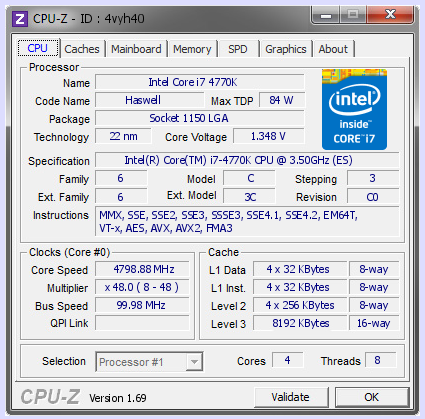BIOS -
BIOS is an acronym that stands for Basic Input/Output System. It is meant to control your product at a very low level. As of right now there are three regularly used BIOS formats (there are actually more than that but there are three common ones). These are the AMI (American Megatrends Incorporated), Award, and Phoenix. Of course with the introduction of the UEFI (Unified Extensible Firmware Interface) we now have a solid basis for the “BIOS” on new motherboards. This actually gets away from the term BIOS (Basic Input/Output System) and becomes more of a software interface. Each manufacturer will have their own take on how to implement this; some good, some not so good. The BIOS on the Z97I Plus is using a newer layout which looks much cleaner and also appears to contribute to performance while moving around in the BIOS. As usual Asus has packed a ton of things into the BIOS, in fact there is too much for us to write about it properly. Instead check out the video we have showing off everything you get.
Overclocking –
Overclocking is one of the fun parts of testing motherboards and CPUs (well really almost every component…). As Intel has developed their CPUs and Chipsets overclocking has become easier to accomplish for even a novice. CPUs and motherboards are designed with considerable headroom to allow for extra voltage and to handle the increase in speed. Gigabyte has been making some excellent progress in providing overclocking performance. They have worked hard to build their boards with the right components and trace layouts. This means that there is less potential for performance loss at high speeds due to signal issues.
Pushing the Z97I Plus was very simple. We had no issues hitting 4.8GHz on this board and feel we could have gone higher with additional tweaking. The additional voltage options found on this board made it a snap to push our 4770K. We would imagine that you would also have no problems pushing one of the new 4790 CPUs on this board as well. We plan on finding out just how far we can go with this new chip on the Z97I Plus a little later on.
Of course overclocking is a picky subject. I can buy to identical CPUs from the store and they will not always perform the same way under stress. This is the same with motherboards, RAM and GPUs. So again it is important to keep in mind that our results represent a specific hardware configuration. Yours may be similar but will rarely be identical.
Overclocking Tools –
Asus’ AISuite has evolved over time to become a very full featured offering. It is designed to give you a single interface for multiple applications and thanks to some fairly good coding the integration of these applications appear seamless to all but the most critical observer. Instead of trying to write about all of the details we walk you through AISuite 3 as it pertains to the Z97I Plus below.
The Test System and Comments -
Our test system is built on an open bench. This has two effects on testing. First it allows us to see everything and also to setup and disassemble the test rigs quickly. Second it means that we cannot gauge the potential air flow found in a normal case. The air is pretty stagnant; some may say this is a great neutral testing method and it can be. However, it does mean that the temperature reading taken off of the components are not accurate to what an average consumer would see. This means that your thermal performance will vary from what we see here.
The Z97I Plus is one of the first small form factor motherboards that we have seen that really shows potential to be run like a full sized board. Asus has packed a lot of high-performance features into this little board and we do expect to see some good performance from it.
Performance testing overview -
Our testing is a little different than most. We combine both synthetic and real-world applications to simulate the types of performance common to the individual products. For motherboards this means that we run roughly six synthetic tests and two real-world. We will be expanding the real-world testing in the near future. But there is more to performance than just the raw numbers. As there are multiple components and sub-components on a motherboard there each item can have a distinct impact on the way the product will perform once you get it in your system. It is important to note not only the actual results but what they mean to you as a potential consumer. We will try to give this information to you.
But we do not just cover the performance aspects that are measurable. We also talk about the components that might not have a direct benchmark. These are items like Audio Quality, ease of use and installation.
Section 1 Subsystems
Memory -
Memory performance is very important on a motherboard, especially when you have a CPU with multiple cores and threads. If you have slow memory your cores and threads can become starved for data to execute. To test memory performance we run both Sisoft’s SANDRA and AIDA64. These two combine to not only give us accurate numbers but to validate each other. For testing at stock speeds the memory is hard set to 16000MHz while overclocking testing is done at the highest stable speed for the voltage of 1.55v this is due to the different memory dividers for each CPU. As such, the memory speeds will vary greatly. This means that the overclocked numbers are a little misleading and while they can show a trend are really only included to show if a board has a problem with memory performance at high clockspeeds. 
The Asus Z97I Plus comes in just behind the two Z87 boards that we have had in the lab. We would have thought that memory performance would have been just as good, if not a little better than the older boards, but that was not the case here. Although the performance is very good, we could see this drop the Z97I behind these two older boards in some of our tests that are memory dependent.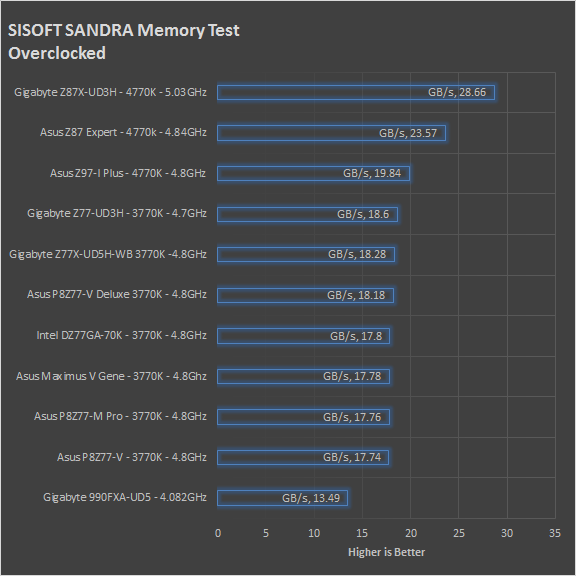
Drive performance -
Drive performance is also one of the major subsystems that goes to make up the performance of a motherboard. For our testing we use Sandra and AIDA64 again. We only test with single drives for each type of controller present on the motherboard (unless it is a professional product where we will use RIAD 5 and/or 10). We have also begun using a Thermaltake USB 3.0 dock with another Kingston SCK30/240G 240GB SSD and a Kingston HyperX USB 3.0 Flash drive for our USB 3.0 performance. As a side note, we include the overclocked numbers here to make sure (again) that you are not going to see a major drop in performance due to minor instabilities at high clock speeds.
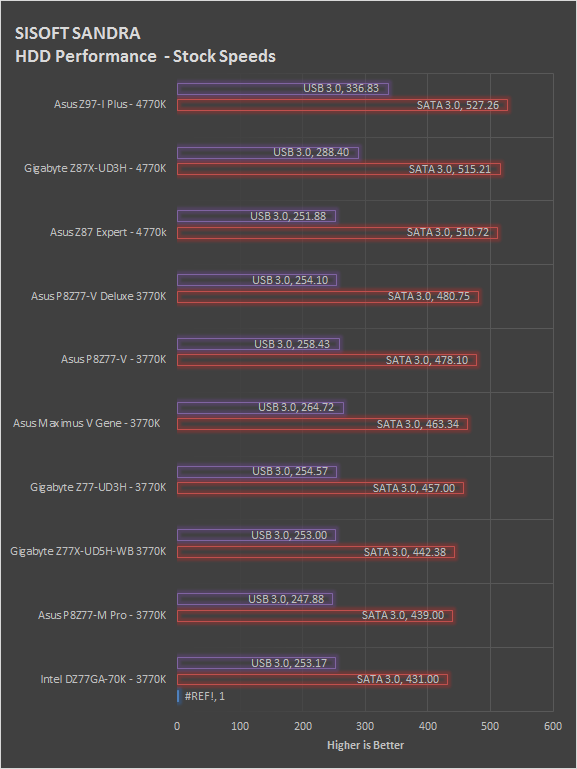
For drive performance we see the Z97I Plus pull out ahead of the pack in our stock testing by a pretty decent margin. We see this same thing happen with the improved USB 3.0 controller.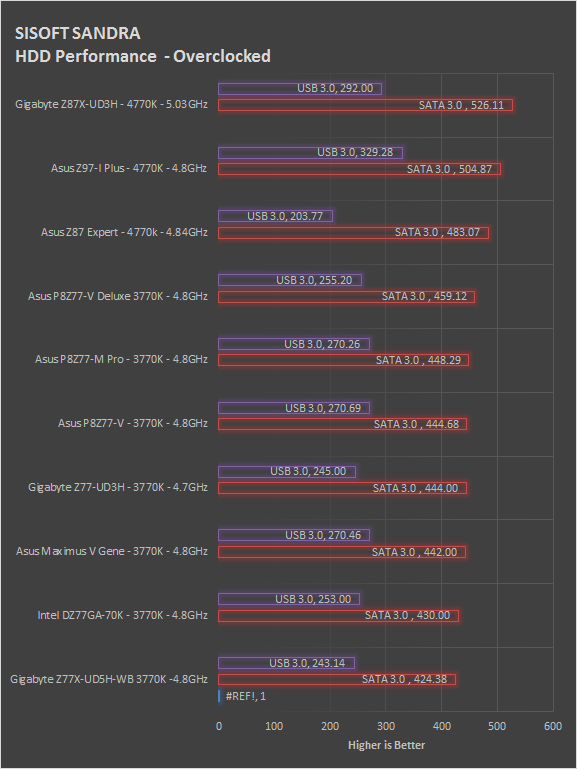
For overclocking we find the Z97I Plus in second place for SATA 3.0 performance, but not for USB 3.0 performance. It would seem that the Z97I is a board you will want to go to, if you are looking to run USB 3.0 drives.
Power -
Power efficiency is another of those misnomers that we get caught up in. We hear about idle states and power gates. But what does that mean to you and I? On the surface having power management that reduces idle power sounds great and can be a benefit to someone that leaves their system on for long periods of time (and inactive) but how a system handles power under load and the delta between the two states is often more important than the idle power usage numbers. We use only P3 Kill A Watt instruments for measuring power.

For a small board the Z97I Plus actually pulls a bit of power in the configuration we have setup. You can get the power down, through the use of Asus’ EPU chip and application, but if you are looking to use all of the power available in your CPU you will still get that power draw.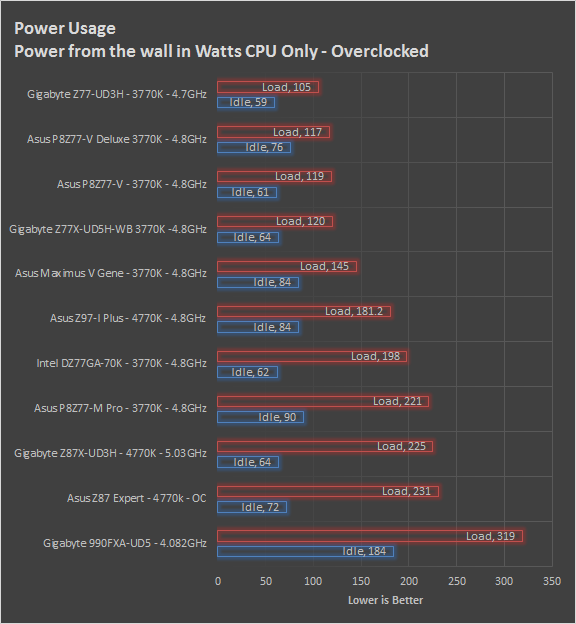
Cooling (Board Level) -
Board level cooling is an important factor in product performance and longevity. Components like the chipset, VRM modules and even capacitors need to be kept relatively cool to prevent failure. As these parts are made of silicon, they have a thermal breakdown threshold; or melting point. At that temperature the actual transistors built into chip will begin to deform and break down. Granted, the threshold is often very high, but you still need to make sure that components stay away from this level of heat for longer product life.

The two heatsinks on the board do a fairly good job of keeping the respective components they cover. We would have liked to see temperatures a little lower, but in reality if you put the Z97I Plus into the right case you will keep these down easily enough.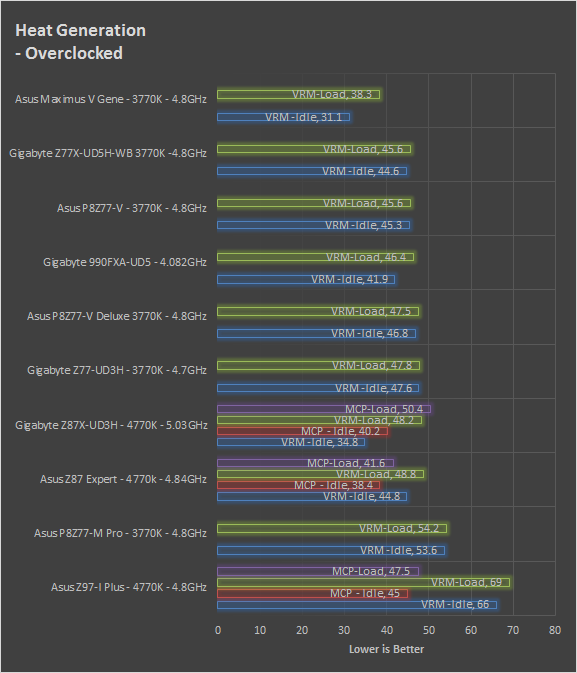
Audio -
Audio is highly subjective. What we find pleasing may sound “off” to you. That is always going to the problem with testing audio; results will vary too widely depending on the tastes of the listener. However, there are ways of measuring the audio output with an objective ear. There is also the issue of audio causing performance issues in gaming and video playback. The reason this is a potential source of concern is that all onboard audio CODECs (Compression/Decompression) are CPU controlled. This means that while the audio chip controls the audio levels and effects of the audio the actual work is done on the CPU. Usually this will not be a problem with today’s powerful CPUs. Even the lower and consumer level products can handle high-end audio these days. But again there is the chance that a bad design or software will hinder your system and performance. On the other side the limits of board space, cost, etc will also prevent the level of audio quality you can get from an add-in board. We test all audio parts with three media types, Movie (DVD), MP3 Music, and Gaming. These are pushed to our Tec On model 55 Tube Amp to see if we can detect any signal issues in the reproduction.
One of the items that Asus has been working on to differentiate their boards is audio. In the Z97I Plus we found the audio experience to be a little better than most of the “good enough” systems that are out there. It is still not going to win any awards, but for an SFF board the audio is quite good.
Networking -
This one is something that is a requirement anymore. If you have a computer, the chances are good (like 99%) that you are also connected to high-speed internet. With this you need a good and solid LAN chip to make sure that your data flows properly out and back.
A few years ago Asus made the decision to use Intel LAN chips on their motherboards for consistency and also for performance. This decision has given them a fairly solid lead on tuning these chips on their boards to get the most performance out of them.
With the Z97I Plus you not only get a fast Intel LAN controller, but also a Braodcomm 802.11ac wireless adapter. It is quite a combination and the performance you get out of them is impressive.
Section II - Performance Tests, Synthetic
In this section of testing we cover the synthetics. These are tests that run a scripted sequence of internal APIs or that use another installed application to perform a series of scripted events. They are great in that they can provide reproducible results across various platforms. On the down side, synthetic tests can be fooled with driver tweaks and optimizations. In some cases it is necessary to rename the .exe file to something generic to discover if this is the case. In any event when this is needed (when a test shows a drastic difference in performance over the renamed exe) we will note this and show both results for comparison.
PCMark 8-
PCMark 8 is a little bit of a departure from PCMark 7. Although the application is still intended for benchmarking and does that quite well the methods used to obtain the results are different. Futuremark has decided to break the tests into usage models instead of performance types. Here we see the tests aligned to the home, work, content creation (creative) and storage functions. We ran all of our tests at baseline (no OpenCL acceleration) to get the feel of the motherboard and its ability to run these tests.
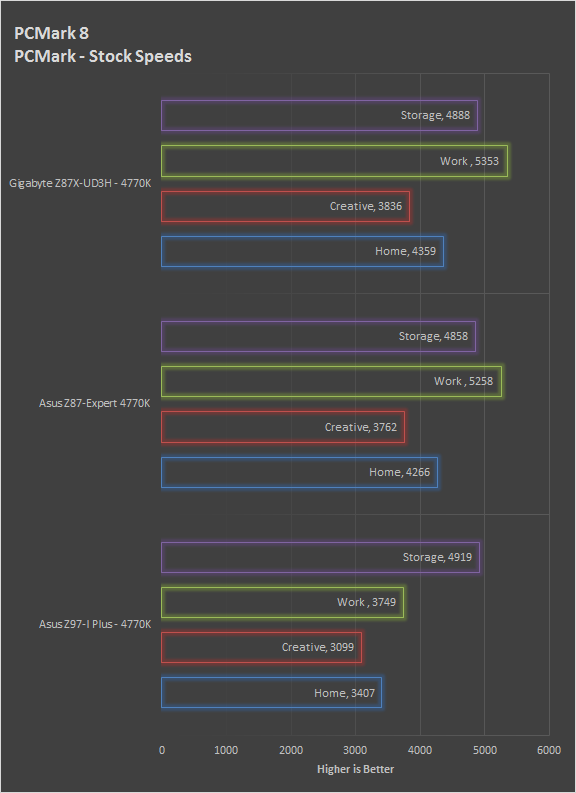
With the exception of the storage test the Z97I is well behind the two Z87 boards we have had in the lab recently. This is a little bit unusual when you think about it. The Z97 chipset is supposed to be much more efficient and should allow any Haswell CPU to perform at its best. In this instance that is just not the case.
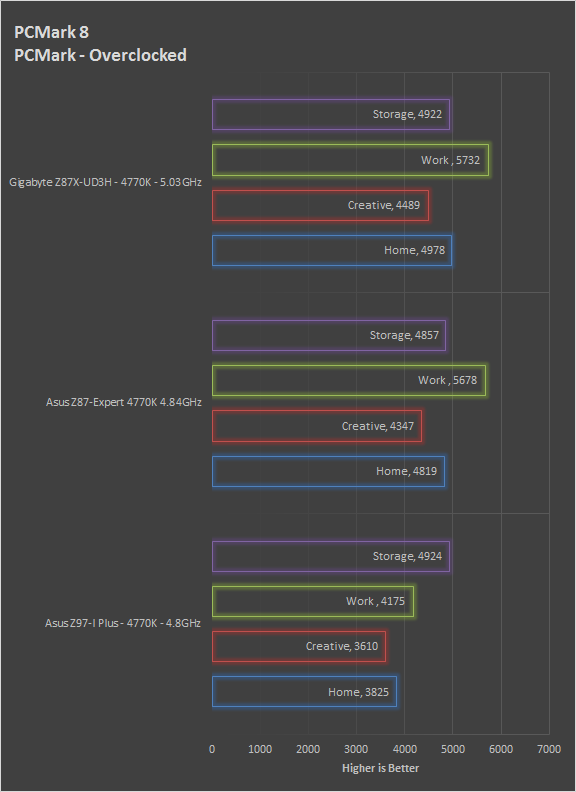
Even in our overclocking tests we see the Z97I Plus lag behind in PC Mark 8.
3DMark -
3DMark is the other Futuremark test that we run on our motherboards. This test simulates the typical tasks that a GPU (and system) would have to perform to provide you with a good gaming experience. It is based on the DX9, DX10 and DX11 engines but can only be installed on Windows Vista or later. The suite of tests covers DX9, DX10, and of course DX11 rendering; it also covers AI computations and physics. That’s right I said Physics the latest version of 3DMark uses a Havok physics engine. This removes the advantage that nVidia had with 3DMark Vantage.
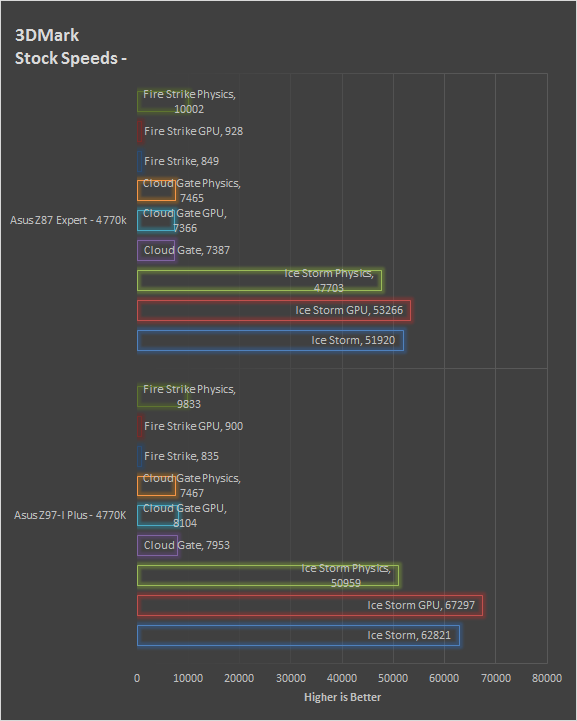 For 3DMark we find that the Z97I is still a little behind the others when you compare them using the Fire Strike bench. Looking at the other two (we did not drop in Sky Diver this time) we find numbers that look a little closer, but the Z97I Plus is still not out in front.
For 3DMark we find that the Z97I is still a little behind the others when you compare them using the Fire Strike bench. Looking at the other two (we did not drop in Sky Diver this time) we find numbers that look a little closer, but the Z97I Plus is still not out in front.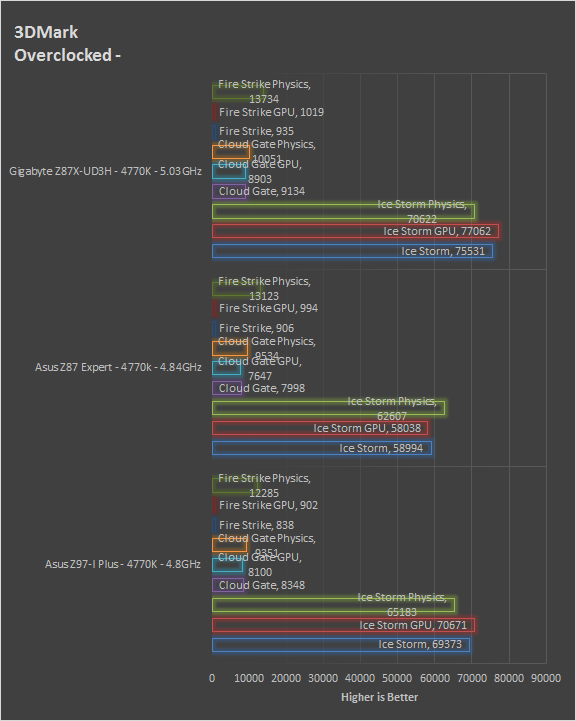
HyperPi 0.99b -
HyperPi is a front end application that allows you to easily run multiple instances of the SuperPi application. SuperPi, for those that are not familiar with it, is an application that measures the time it takes to calculate the number Pi out to as many as 32 million places. This calculation is then checked and run multiple times (up to 24 for a 32M run). This test stresses the CPU, Memory and HDD as data is handed off between the three. If there is a weak link, HyperPi will show it. For our testing we run the 32M test on as many cores (and threads) as the CPU has available. The slowest CPU time is then recorded. The blue bars indicate the slowest time while the red indicate the fastest.

At stock speeds the Z97I Plus is pretty fast, but it still finds itself behind the Z87 boards. Overclocked things slip quite a bit and the Z97I Plus drops way down in the group.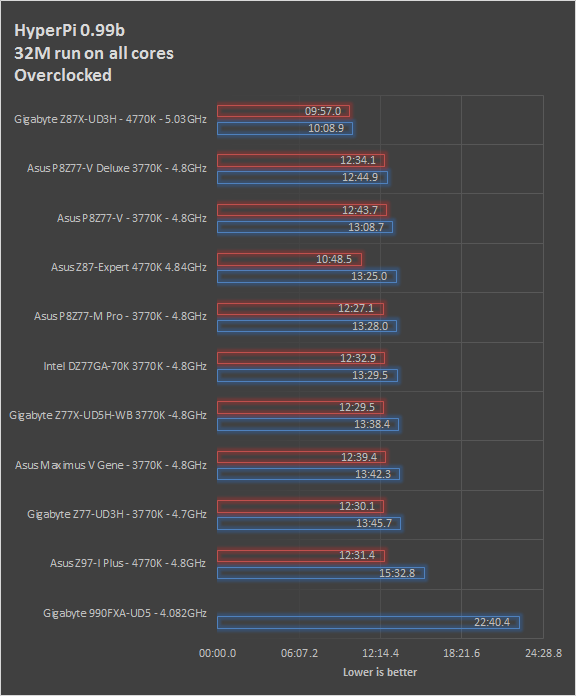
Cinebench R15 -
Cinebench R15 is the 15th release of Maxon’s rendering test. This test is based off of the Cinema 4D engine, which is one of the industry standard tools for digital animation. It is a powerful product with many different modules that can be “plugged” into it to increase its effectiveness. With Cinebench you get to see how your computer would do using this application. There are two tests; one tests the CPU’s ability to render an image across multiple cores or threads. The other tests your systems ability to handle OpenGL based rendering.
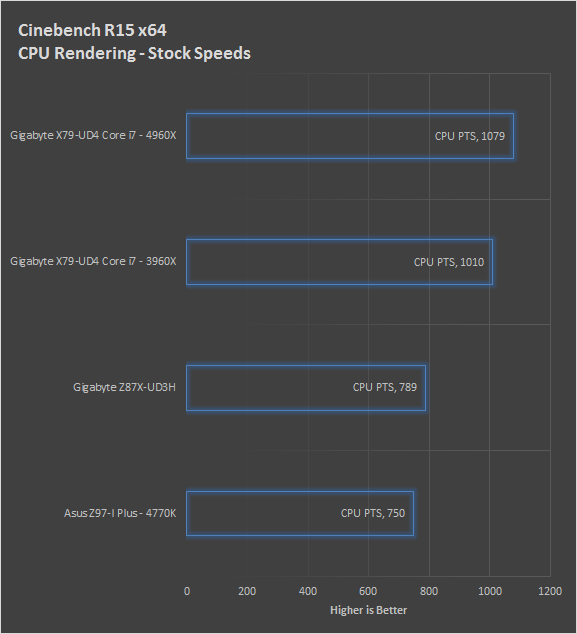
Under the CPU rendering tests in Cinebench R15 the Z97I Plus is at the bottom of the list. The gap is not that big, but it is enough to be outside of normal deviation.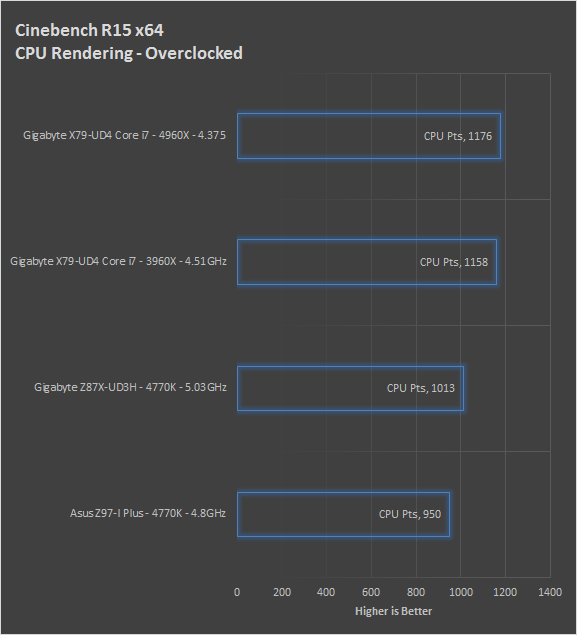

Under the OpenGL testing we find the Z97I Plus out in front of the Z87 boards. Granted it cannot keep up with the discrete GPUs we used on the X79 boards, but it still shows fairly solid performance for an internal GPU.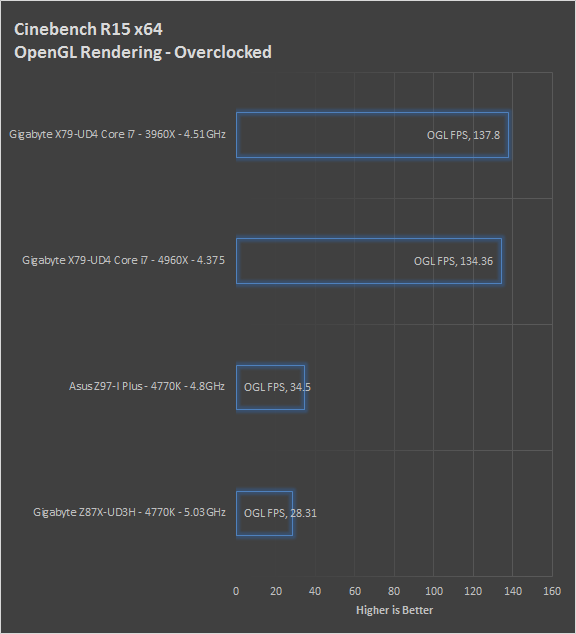
Section III - Performance Tests, Real-World
Here we have two tests that are designed to put the performance of the motherboard and its subsystems to the test. Both require good CPU, Memory, HDD and even to a lesser extent audio and network performance. The two tests we chose were Lightwave 3D 9.6 and CyberLink’s Media Espresso. We will be adding at least one more real-world test to this battery in the near future, but for now these two cover quite a bit.
LightWave 3D 11 x64 -
Lightwave is another industry standard application for 3D animation and rendering. It has a large tool base and the rendering engine is highly threaded (when using the right render model). This application is also capable of expanding to 4k resolutions as well as ray tracing for rending the light sources. For our testing we use frame 308 of the Flocking-Alien Army scene found in the LW 11 Content folder. This uses perspective cameras which is better suited to a multi-CPU/Core environment. This camera style also uses ray tracing and a much improved anti-aliasing method. Settings are shown below in the attached screen shot. Of course these are single frame renders and they are not a complete picture; for that you have to take into account the number of frames an average project would have. In a typical 30 second commercial you will have around 840 to 960 frames (at 28 – 32 FPS) this means that you have to multiply the time of a single frame by that number just to get a vague idea of how long that 30 seconds would take. This is because each frame will have a different render time based on complexity.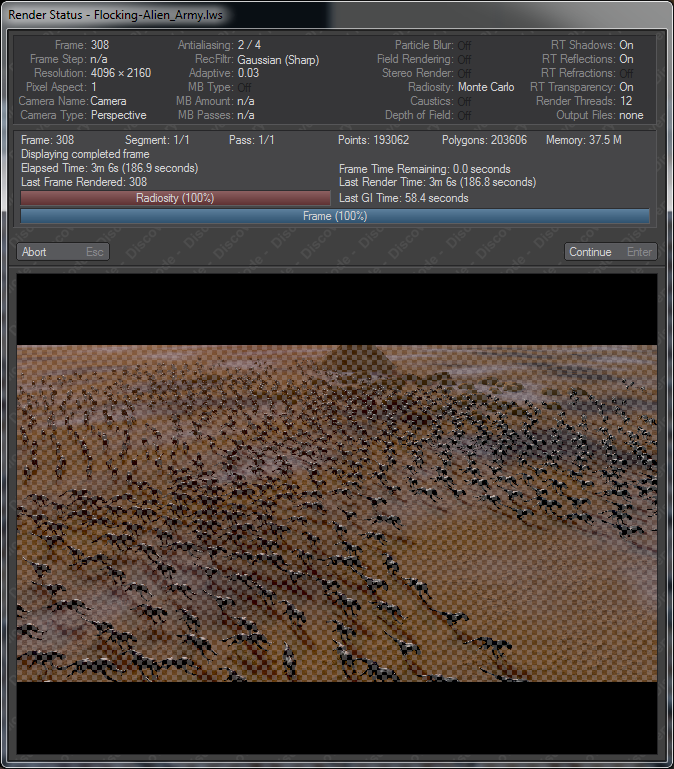

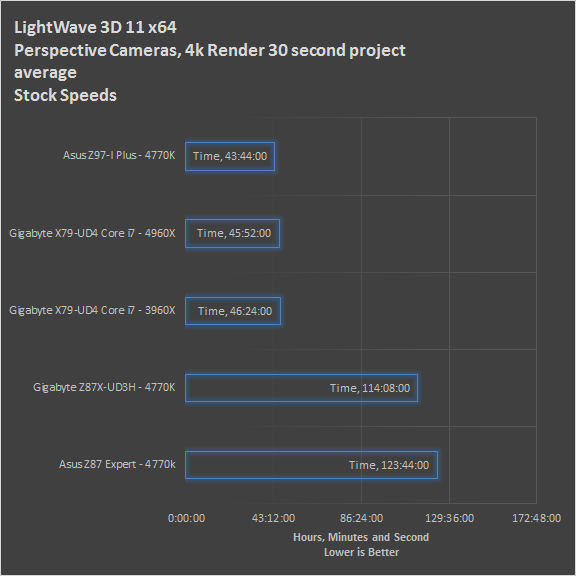
Lightwave shows us another side of the Z97I Plus. Here we see it pull ahead of many of the other systems we have tested in the past.
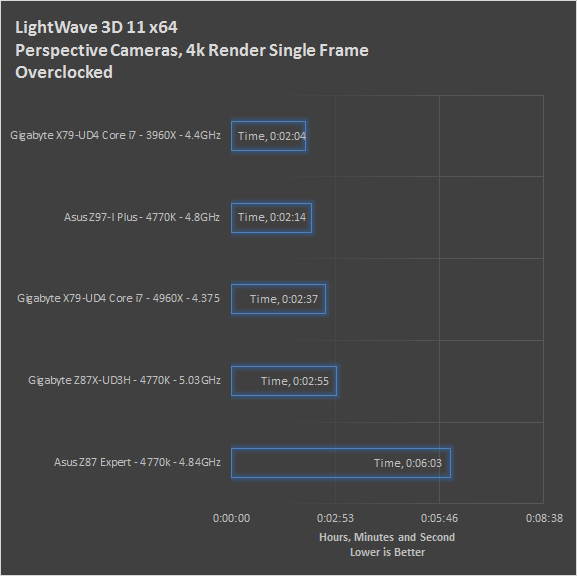
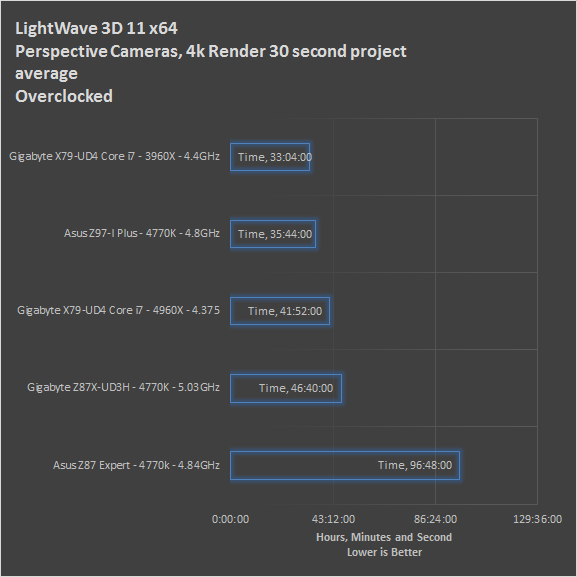
Overclocked the Z97I Plus drops back a little due to the lower OC we hit on it.
CyberLink Media Espresso 6.5 -
After having various issues with AutoGK and Intel CPUs with more than four cores we have changed our Media Encoding test to use Media Espresso from CyberLink. Although this new utility does not have the same ability to transfer directly from DVD it is still a good test to transfer different media types into a usable format for your iPad, iPod, or other media player. Our test involves using multiple (Six) 20 minute media files and transcoding them for an iPad. This gives us a very good indication of how well a motherboard can handle this type of work load.
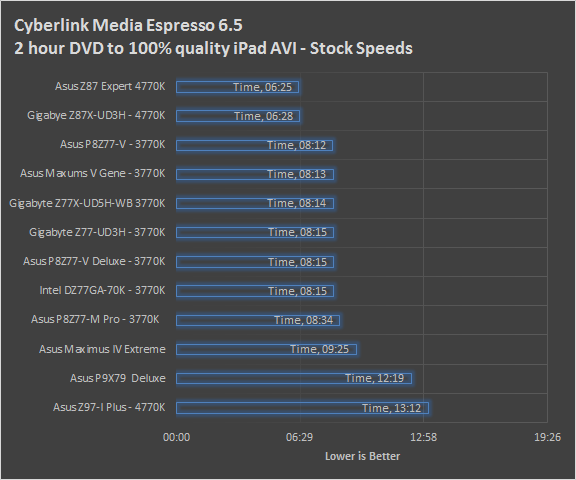 Now this in interesting, using the same files we see the time to complete the transcoding almost double compared to Z87 boards. Even the slower memory speed does not account for this issue. It seems that there is something that bottlenecks this application on the Z97I Plus.
Now this in interesting, using the same files we see the time to complete the transcoding almost double compared to Z87 boards. Even the slower memory speed does not account for this issue. It seems that there is something that bottlenecks this application on the Z97I Plus.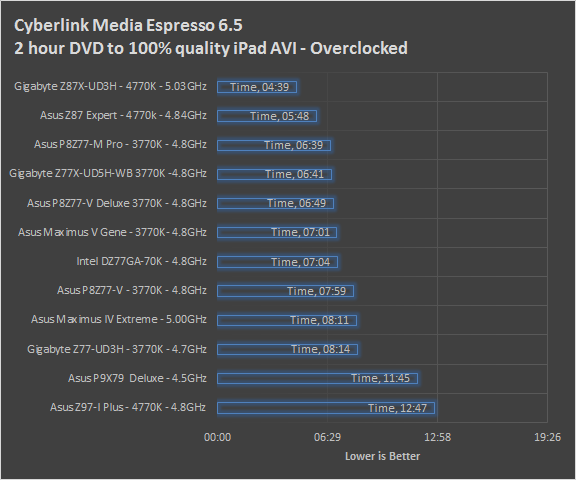
Section IV Performance – Gaming
Gaming as a test of motherboard performance is sort of a joke these days. The big player in the gaming arena is the GPU. Everyone but a few hardcore PR teams know this. However, it is important to run at least a few (one from each current DX version) to see if there are any issues with the combination of components on a motherboard. These are items like Audio lag, memory lag and of course problems with the PCIe lanes and signal traces. If there are issues in design, drivers or BIOS then you can have odd gaming performance. So without much more preamble let’s dive into the three games we currently use; Call of Duty Modern Warfare 3 and Total War Napoleon for DX9 and Civilization V for DX11.
Call of Duty Modern Warfare 3 DX9 -
As the third installment in the Modern Warfare franchise you are picking up some old roles while adding a couple of new ones as well. The game play is almost identical to what you are used to in Modern Warfare 2 as are the graphical settings. The AI is a little different thought it is still similar to the bar fight style AI we like in the Call of Duty series. For our testing we run the first mission (Black Tuesday) from start to finish. Settings are shown below.
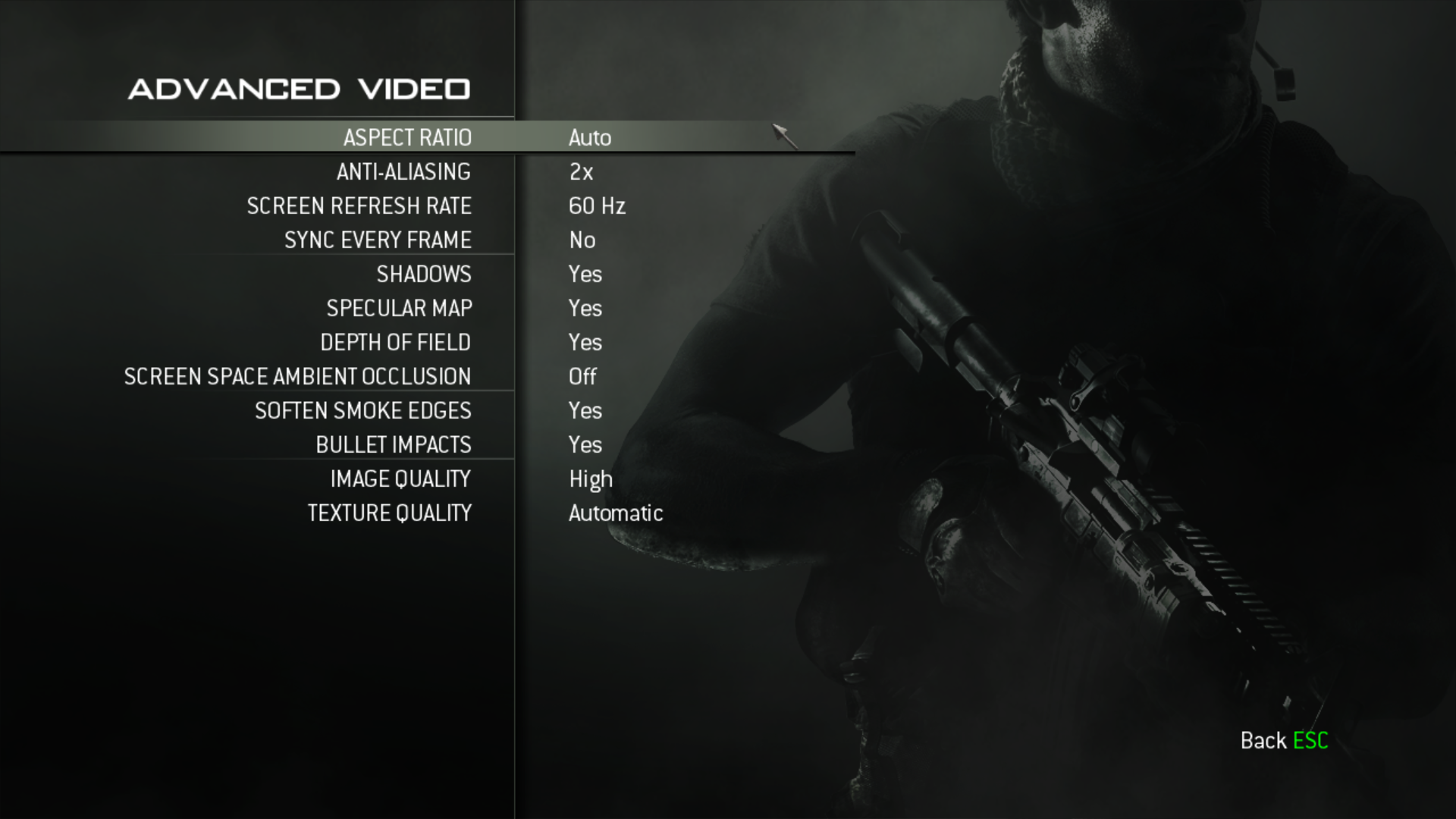 |
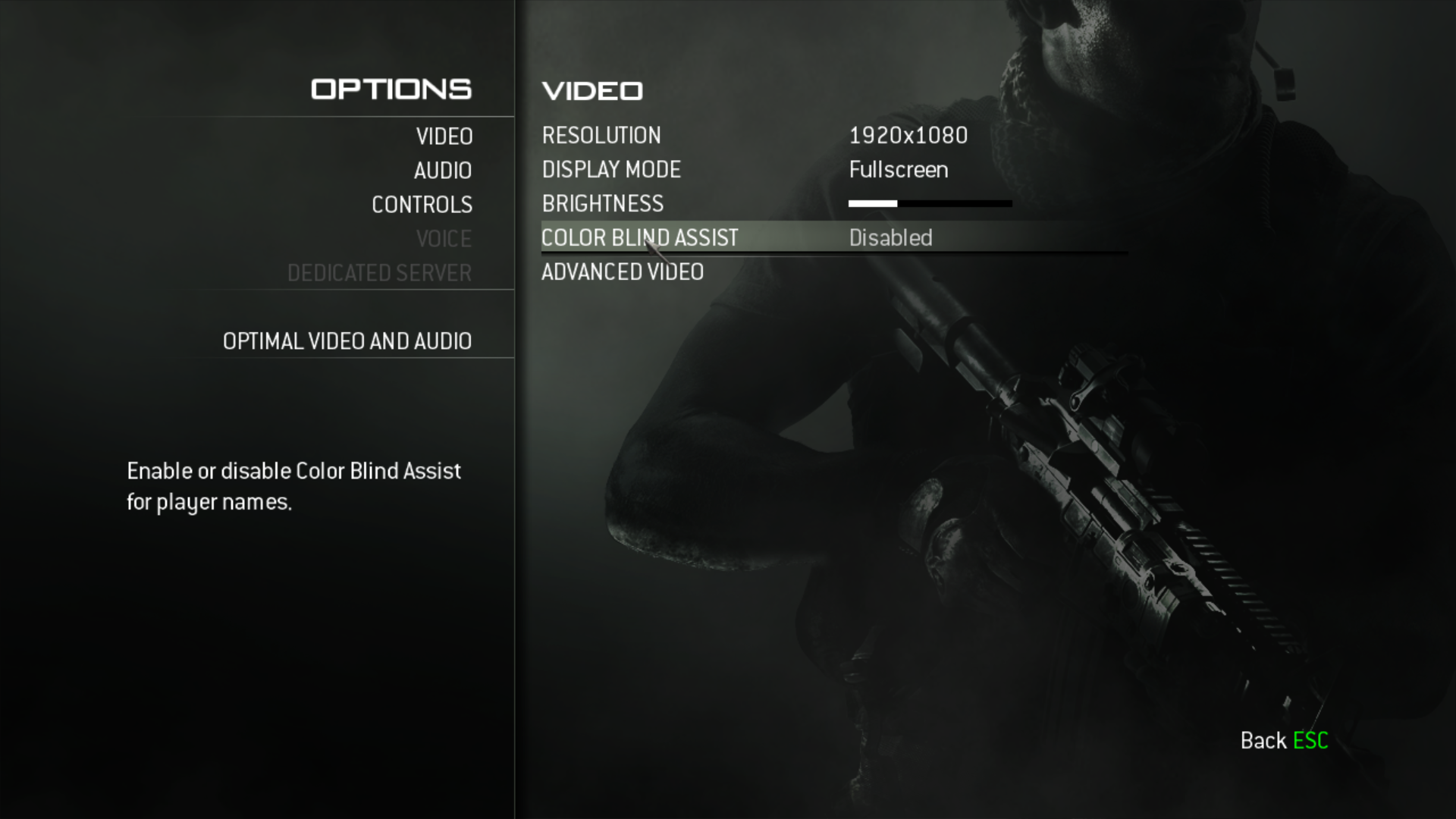 |
 |
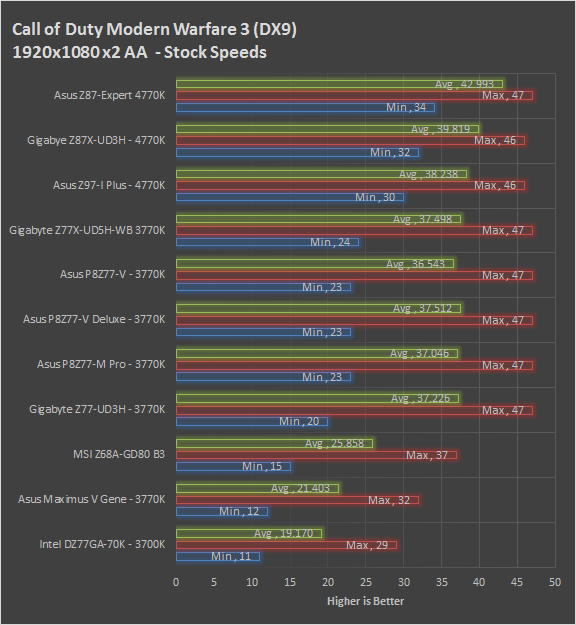
The Z97I Plus cuts through Modern Warfare 3 with ease. We see frame rates that will be more than enough to keep you happy with this game. On the audio side the Z97I Plus does a great job of reproducing the sounds in the game.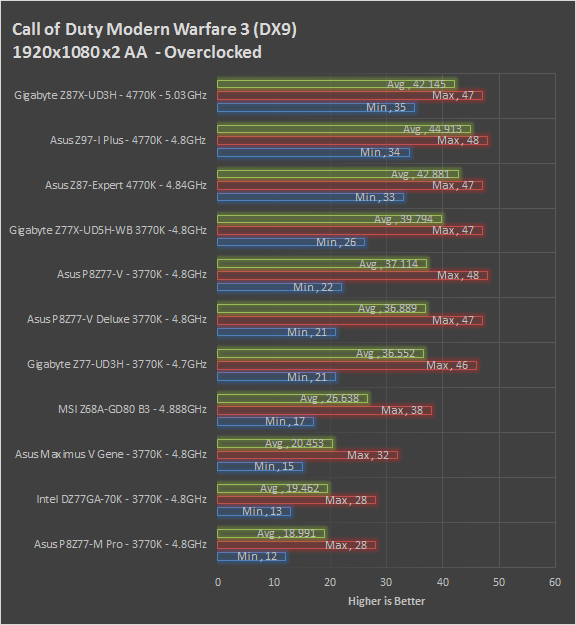
Total War Napoleon DX9 -
Napoleon Total War is a turn based strategy game that puts you in charge of Napoleon’s army during the height of his power. The game has some very interesting strategic systems although it can be boring when you are moving units into place. One of the more interesting things about Napoleon Total war is that the more CPU power you have at hand the better the game performs. This is because the system AI is dynamic and improves based on the resources available. For our testing we ran through the Lodi campaign. You can see the settings below.
 |
 |
 |
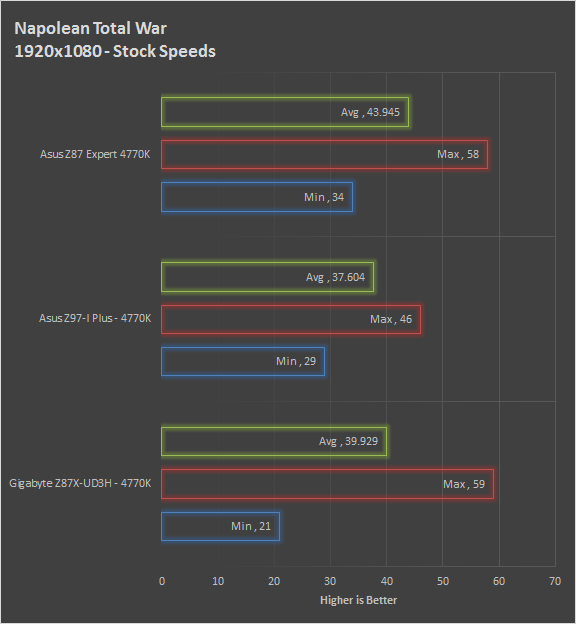
Total War Napoleon is an interesting game, It actually gets a boost from the CPU where many other games are limited to just what the GPU can push. We see this in the performance on the Z97I Plus with the Core i7 4770K. We were not able to push the graphics to the max, but we can see solid gaming performance at the levels we tested at.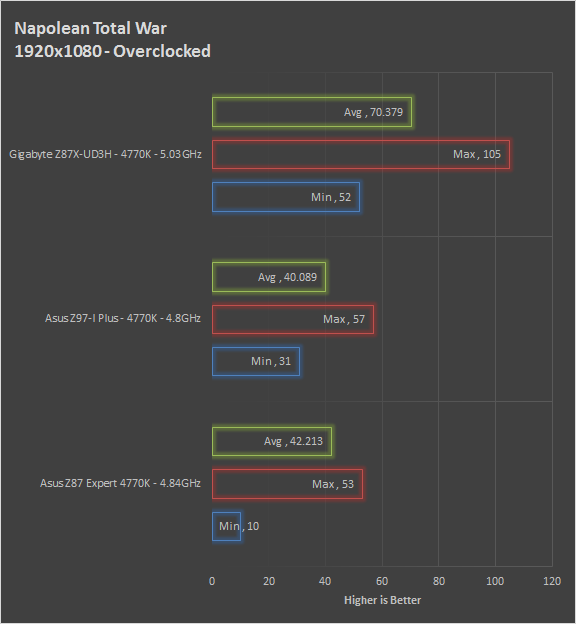
Civilization V DX11 –
Civilization V is a strategy game that pits you against other world leaders. You must advance your civilization and try to beat your opponents through military prowess, scientific achievement, or just lasting longer than they do. For our testing we ran through 30 minutes of game play using the same country and leader. We mapped out a city and production strategy attempting to move through the game the same way during all three test runs. You can check out the settings below along with a screenshot.
 |
 |
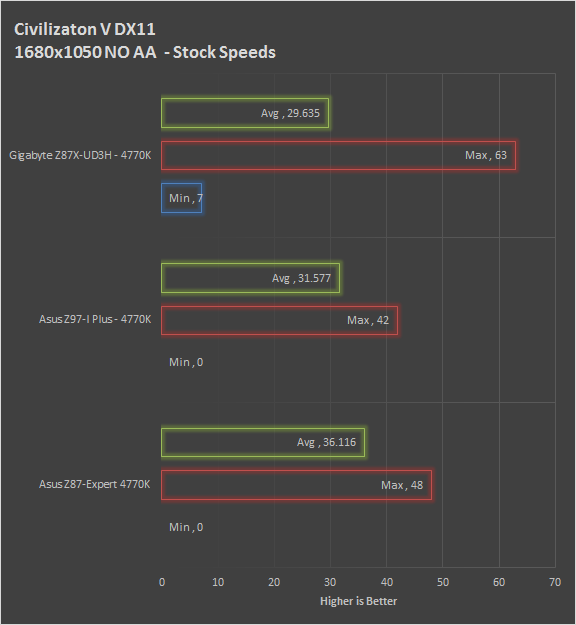 Once again the Z97I Plus does fairly well with the game we threw at it. This time, in Civilization, we see the Z97I Plus do quite well when you take a look at average frame rates. Again we were not able to push the resolution or eye candy to its limit, but all-in-all the game experience was very good.
Once again the Z97I Plus does fairly well with the game we threw at it. This time, in Civilization, we see the Z97I Plus do quite well when you take a look at average frame rates. Again we were not able to push the resolution or eye candy to its limit, but all-in-all the game experience was very good.
Gaming wrap-up -
In all the gaming performance on the Z97I Plus was fairly solid. It is not going to run many of the AAA titles that are out there, but it is sure to handle almost any mainstream game you care to throw at it. You get solid audio, great network options (~800Mbps Wireless) and very fast load times thanks the SATA performance that we saw. You also do always have the option to drop in a GPU so you can play just about any game you want.
Value -
Value is another very subjective topic. What is expensive to some might be a deal to others. You can look at this topic in multiple ways. One is raw price and the other is what you get for the money. Each is accurate and both are correct ways to look at price/value. We tend to look at features, performance and real-property when we discuss value. However, we also take into account the raw cash cost of the item. The Z97I Plus is listed at $159.99 on most of the e-tail sites we looked at. This seems like quite a bit for such a small board. However, if you consider just the 802.11ac wireless the price becomes much more palatable (if that is what you are looking for). If the wireless does not excite you there are other features that might. The overclocking potential on the Z97I Plus is excellent so this would make a decent platform for pushing your CPU. In all the price is a little on the high-side for the basic performance of the board, but the feature set does offset that.
Conclusion -
When we first looked over the Z97I Plus we felt it had great potential for performance as well as overclocking. Although we did not see the performance levels we had hoped for, we did see some very solid overclocking with the Z97I Plus pushing our 4770k to 4.8GHz without too much trouble. We also do not feel that the performance levels put the Z97I Plus out of the running. It is still a very capable board when you consider the fact that it is a Mini-ITX board. If features are what you are looking for then the Z97I Plus has a lot for you to look at. You have an M.2 SSD slot, 802.11ac wireless, great overclocking support, clean audio all in a small package. You can take the Z97I Plus and make it the basis for a very powerful SFF system. So if you are looking for a solid platform for your next micro build the Asus Z97I Plus should be on your list.
Tell us what you think in our Forum

